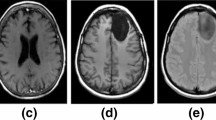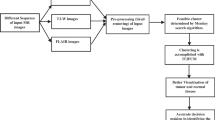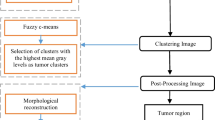Abstract
Brain tumor segmentation is a significant procedure in medical image processing. Effective and efficient segmentation is always a key concern for the radiologists due to the presence of low illumination in imaging modalities of Magnetic Resonance (MR) imaging. Some of the challenging issues addressed in this paper are the sensitivity of noise, variations, and non-standardization in inter-slice intensity, and intensity inhomogeneity. A reliable segmentation method for the brain tumor segmentation is necessary for efficient measurement of the tumor. The foremost objective of the research is to fuse the different modalities of MRI images by considering the most useful features to obtain the best segmentation. Sufficient diagnostic information in clinical applications is not provided by single modality images. Therefore, combining the features of different modalities of images is vital. Recently, many researchers applied many techniques for fusing medical images, still many issues are to be addressed. Hence, to combine different modality of images, a novel fusion method is proposed. Our proposed work contains four stages (i) pre-processing, (ii) feature extraction (iii) feature fusion, and (iv) segmentation. In the pre-processing step, the image quality is increased and the unwanted noise is removed using average filtering. In the feature extraction stage, the Extended Grey Level Co-occurrence Matric (E-GLCM) is introduced to extract the suitable intensity and texture features of brain tumor MRI images. To fuse the correct features for efficient segmentation, the Enhanced Fuzzy Radial Basis function Neural Network (E-FRBNN) incorporates five layer inputs, fuzzy partition, front combination, inference, and output. Finally, the segmentation is carried by thresholding based segmentation approach with morphology operators. The simulation results of the proposed segmentation procedure acquire competitive performance when compared with the existing techniques for the BRATS 2015 dataset.






Similar content being viewed by others
Change history
16 March 2021
The original version of this paper was updated to present the correct email addresses of the authors.
References
Alansary A, Ismail M, Soliman A, Khalifa F, Nitzken M, Elnakib A, Zurada JM (2016) Infant brain extraction in T1-weighted MR images using BET and refinement using LCDG and MGRF models. IEEE Journal of Biomedical and Health Informatics 20(3):925–935
Binaghi, E., Omodei, M., Pedoia, V., Balbi, S., Lattanzi, D., & Monti, E. (2014). Automatic segmentation of MR brain tumor images using support vector machine in combination with graph cut. In IJCCI (NCTA), pp. 152–157.
Chen H, Dou Q, Yu L, Qin J, Heng PA (2017) VoxResNet: deep voxelwise residual networks for brain segmentation from 3D MR images. NeuroImage
Deepa AR, Emmanuel WS (2019 May 1) An efficient detection of brain tumor using fused feature adaptive firefly backpropagation neural network. Multimed Tools Appl 78(9):11799–11814
Deng Y, Ren Z, Kong Y, Bao F, Dai Q (2017) A hierarchical fused fuzzy deep neural network for data classification. IEEE Trans Fuzzy Syst 25(4):1006–1012
Despotović I, Goossens B, Philips W (2015) MRI segmentation of the human brain: challenges, methods, and applications. Computational and mathematical methods in medicine 2015:23
Dimitriadis SI, Liparas D, Tsolaki MN, Alzheimer's Disease Neuroimaging Initiative (2018) Random forest feature selection, fusion and ensemble strategy: combining multiple morphological MRI measures to discriminate among healhy elderly, MCI, cMCI and Alzheimer’s disease patients: from the alzheimer’s disease neuroimaging initiative (ADNI) database. J Neurosci Methods 302:14–23
El-Dahshan ESA, Mohsen HM, Revett K, Salem ABM (2014) Computer-aided diagnosis of human brain tumor through MRI: a survey and a new algorithm. Expert Syst Appl 41(11):5526–5545
Havaei M, Davy A, Warde-Farley D, Biard A, Courville A, Bengio Y, Larochelle H (2017) Brain tumor segmentation with deep neural networks. Med Image Anal 35:18–31
Işın A, Direkoğlu C, Şah M (2016) Review of MRI-based brain tumor image segmentation using deep learning methods. Procedia Computer Science 102:317–324
Islam A, Reza SM, Iftekharuddin KM (2013) Multifractal texture estimation for detection and segmentation of brain tumors. IEEE Trans Biomed Eng 60(11):3204–3215
James, A. P., & Dasarathy, B. (2015). A review of feature and data fusion with medical images. arXiv preprint arXiv:1506.00097.
Kwon, D., Shinohara, R. T., Akbari, H., & Davatzikos, C. (2014) Combining generative models for multifocal glioma segmentation and registration. In International Conference on Medical Image Computing and Computer-Assisted Intervention, pp. 763-770.
Lahmiri S (2017) Glioma detection based on multi-fractal features of segmented brain MRI by particle swarm optimization techniques. Biomedical Signal Processing and Control 31:148–155
Lakshmi, A., Arivoli, T., & Rajasekaran, M. P. (2017). A novel M-ACA-based tumor segmentation and DAPP feature extraction with PPCSO-PKC-based MRI classification. Arabian journal for science and engineering, pp.1-17.
Lesage D, Angelini ED, Bloch I, Funka-Lea G (2009) A review of 3D vessel lumen segmentation techniques: models, features and extraction schemes. Med Image Anal 13(6):819–845
Ma C, Luo G, Wang K (2018) Concatenated and connected random forests with multiscale patch driven active contour model for automated brain tumor segmentation of MR images. IEEE Trans Med Imaging 37(8):1943–1954
Mangai UG, Samanta S, Das S, Chowdhury PR (2010) A survey of decision fusion and feature fusion strategies for pattern classification. IETE Tech Rev 27(4):293–307
Meng X, Jiang R, Lin D, Bustillo J, Jones T, Chen J, Sui J (2017) Predicting individualized clinical measures by a generalized prediction framework and multimodal fusion of MRI data. Neuroimage 145:218–229
Nabizadeh, N. (2015). Automated brain lesion detection and segmentation using magnetic resonance images.
Nongmeikapam K, Kumar WK, Singh AD (2017) Fast and automatically adjustable GRBF kernel based fuzzy C-means for cluster-wise coloured feature extraction and segmentation of MR images. IET Image Process 12(4):513–524
Parekh P, Patel N, Macwan R, Prajapati P, Visavalia S (2014) Comparative study and analysis of medical image fusion techniques. International Journal of Computer Applications 90(19)
Pereira S, Pinto A, Alves V, Silva CA (2016) Brain tumor segmentation using convolutional neural networks in MRI images. IEEE Trans Med Imaging 35(5):1240–1251
Rajinikanth V, Satapathy SC, Dey N, Vijayarajan R (2018) DWT-PCA image fusion technique to improve segmentation accuracy in brain tumor analysis. InMicroelectronics, electromagnetics and telecommunications (pp. 453-462). Springer. Singapore.
Reed TR, Dubuf JH (1993) A review of recent texture segmentation and feature extraction techniques. CVGIP: Image understanding 57(3):359–372
Selvapandian A, Manivannan K (2018 Nov 1) Fusion based glioma brain tumor detection and segmentation using ANFIS classification. Comput Methods Prog Biomed 166:33–38
Shattuck DW, Sandor-Leahy SR, Schaper KA, Rottenberg DA, Leahy RM (2001) Magnetic resonance image tissue classification using a partial volume model. NeuroImage 13(5):856–876
Shree NV, Kumar TNR (2018) Identification and classification of brain tumor MRI images with feature extraction using DWT and probabilistic neural network. Brain Informatics 5(1):23–30
Sun QS, Zeng SG, Liu Y, Heng PA, Xia DS (2005) A new method of feature fusion and its application in image recognition. Pattern Recogn 38(12):2437–2448
Zhang N, Ruan S, Lebonvallet S, Liao Q, Zhu Y (2011) Kernel feature selection to fuse multi-spectral MRI images for brain tumor segmentation. Comput Vis Image Underst 115(2):256–269
Zhao X, Wu Y, Song G, Li Z, Zhang Y, Fan Y (2018 Jan 1) A deep learning model integrating FCNNs and CRFs for brain tumor segmentation. Med Image Anal 43:98–111
Zulpe N, Pawar V (2012) GLCM textural features for brain tumor classification. International Journal of Computer Science Issues (IJCSI) 9(3):354
Author information
Authors and Affiliations
Corresponding author
Additional information
Publisher’s note
Springer Nature remains neutral with regard to jurisdictional claims in published maps and institutional affiliations.
Rights and permissions
About this article
Cite this article
Kumar, G.A., Sridevi, P.V. E-fuzzy feature fusion and thresholding for morphology segmentation of brain MRI modalities. Multimed Tools Appl 80, 19715–19735 (2021). https://doi.org/10.1007/s11042-020-08760-6
Received:
Revised:
Accepted:
Published:
Issue Date:
DOI: https://doi.org/10.1007/s11042-020-08760-6




